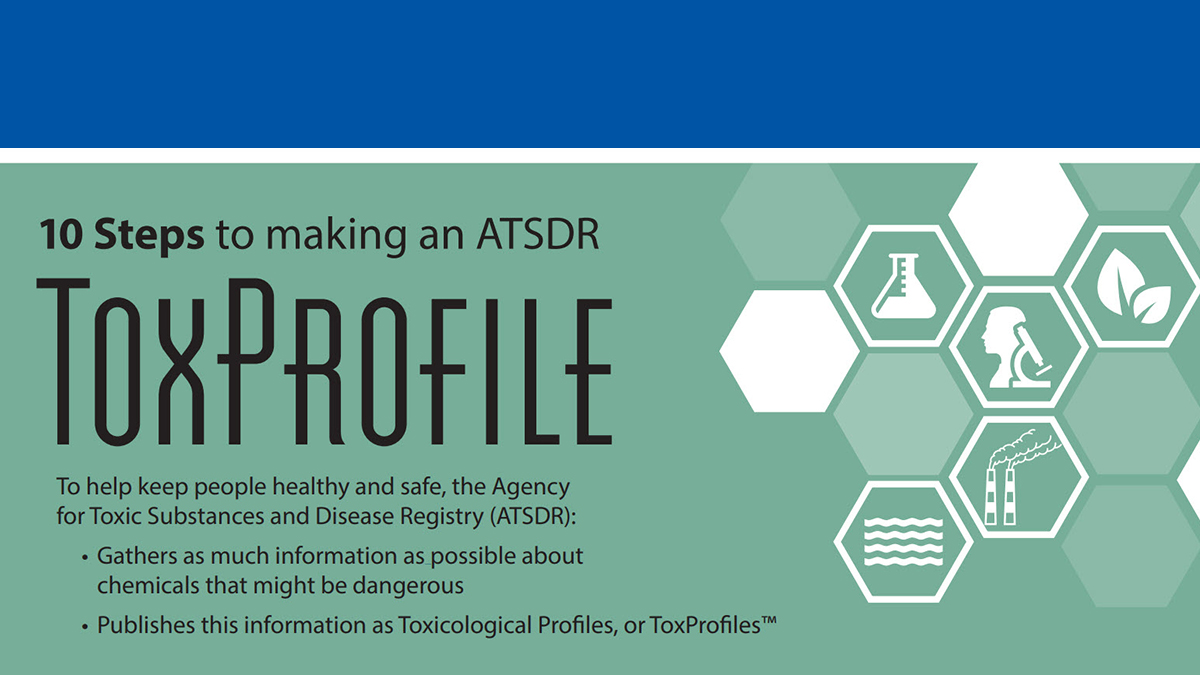Purpose
- To help keep people healthy and safe, the Agency for Toxic Substances and Disease Registry (ATSDR):
- Gathers as much information as possible about chemicals that might be dangerous
- Publishes this information as Toxicological Profiles, or ToxProfilesTM

What are ToxProfiles?
- ToxProfiles give information on how hazardous (poisonous) substances may affect health.
- Each ToxProfile includes a Public Health Statement, a summary chapter that outlines the ToxProfile's information on hazardous substances and its potential health effects. A shorter, more reader-friendly version of the profile, known as a ToxFAQs, is also available.
- Many toxicologists (scientists who study harmful chemicals) rely on ToxProfiles to do their work.
Steps to make a Toxprofile
1. Prioritize toxic substances
We develop the Substance Priority List (SPL) which lists chemicals found at hazardous waste sites on the National Priorities List (NPL).
- Hazardous waste sites are properties where toxic (harmful) substances have been left behind.
- The NPL is a list of important hazardous waste sites that the Environmental Protection Agency (EPA) is cleaning up.
The substances on the SPL are prioritized based on:
- How toxic they are
- How often they have been found at NPL sites
- How likely people have been exposed
2. Select ToxProfiles
We select ToxProfiles based on:
- The SPL
- New scientific research
- If individuals, organizations, or agencies have requested a ToxProfile
Anyone can suggest a ToxProfile
Every year, we request nominations for profiles. Members of the public, government agencies, or private organizations can tell us which chemicals they are worried about.
3. Conduct a comprehensive literature review
We gather and review all the published scientific research available to form a complete picture of each substance. Then, we create a draft ToxProfile.
4. Develop Health Guidance Values (HGVs)
Our scientists review the draft ToxProfile and decide on Minimal Risk Levels (MRLs) for that substance.
- MRLs estimate how much of a certain kind of exposure (contact) to a hazardous substance will likely not make people sick (like by breathing toxic fumes or drinking contaminated water).
- MRLs can help public health professionals know who's at risk of getting sick in a certain location.
5. Perform comprehensive internal and external review of the profile
- Other government agencies (inter-agency review)
- Experts within CDC/ATSDR
6. Conduct independent peer review
- Non-government independent experts review the profile.
- Profiles are revised (as needed) based on peer review comments.
- Peer review comments are posted on the web.
7. We post a draft of the ToxProfile and invite comment on it at www.regulations.gov
- The public comment period is 90 days.
- We announce the release of the draft for public comment profile via Federal Register announcement and on our website.
8. Review and respond to public comments
- We summarize all comments and concerns received during the public comment period and revise the profile as needed.
- Comments are available for viewing on regulations.gov.
- Our response to public comments is available from the public docket.
9. Complete additional intra-agency review, peer review, and clearance
10. After final review and agency clearance, we post the final ToxProfile online
- We announce on our website that a new ToxProfile is available.
- We let people know about it via a Federal Register Notice.
- All the profiles are free for the public to access and use at: http://www.atsdr.cdc.gov/toxicological-profiles/about/index.html.
Did you know?
- Over the past 20 years, ATSDR has developed more than 300 ToxProfiles.
- ToxProfiles are recognized nationally and internationally as credible sources of information for public health professionals.
- We review high-priority ToxProfiles each year, as well as new substances, and choose several to update or create.

